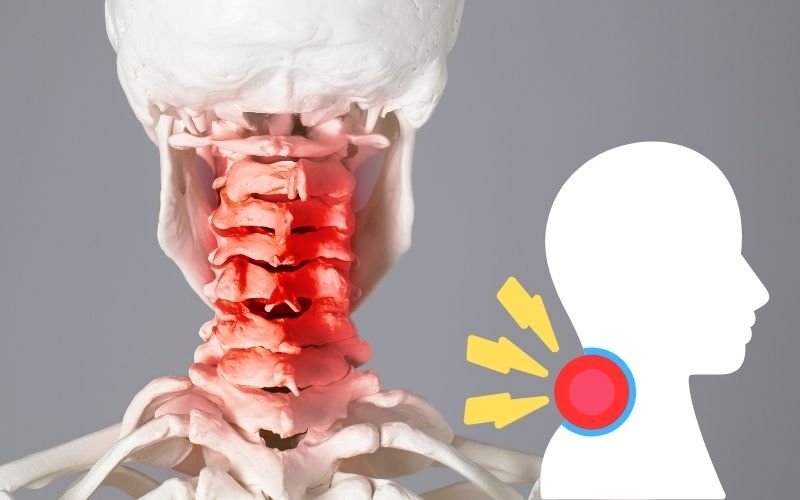Cervical neck pain affects many people around the world. It starts in the upper spine and moves to the back, shoulder, or even the arms. This type of pain can be dull or sharp. It might come from poor posture, an injury, or stress. Sometimes, it is a warning sign of a deeper issue. People feel stiff, sore, or find it hard to turn their neck. If not managed early, it can affect daily work, sleep and health
In this article top orthopedician in Delhi explains about ways to relieve cervical pain. We explain simple methods, treatments, and exercises. We also help you understand the causes and signs to watch out for. If you feel neck pain often, or if your job includes long sitting hours, this article is for you. Read till the end for expert advice and tips from The Bone Clinic.
What Causes Cervical Neck Pain?
Cervical pain begins in the seven vertebrae of the neck. These bones support your head and allow it to move. The neck has nerves, muscles, joints, and discs. When any part of this area gets strained or hurt, pain follows.
Common causes include:
- Poor posture while sitting, using a laptop, or phone
- Lack of regular cervical exercise
- Sleeping without a proper cervical pillow
- Sudden jerks or whiplash during travel
- Lifting heavy objects wrongly
- Arthritis or disc degeneration with age
- Cervical rib or extra rib pressing nerves
Sometimes, internal problems like infections, tumors, or cervical incompetence during pregnancy also lead to neck pain. It is important to understand what’s triggering the pain so you can take the right steps.
Early Signs and symptoms of Cervical Neck Pain
Many people ignore the early signs of cervical pain. But identifying the symptoms can help prevent long-term damage.
Look out for:
- Stiffness or tightness in the neck
- Pain that spreads to shoulders or arms
- Tingling in fingers or hands
- Headaches at the base of the skull
- Muscle weakness in the upper limbs
- Pain after long screen time or travel
When you notice these signs, it’s best to seek help from a orthopedics in Dwarka Delhi or nearby.
Best Cervical Neck Pain Exercises
Simple neck exercises can bring relief if done regularly and correctly. These cervical neck pain exercises strengthen muscles and improve flexibility. Always warm up before starting and stop if any move causes sharp pain.
Here are some helpful cervical exercises:
- Neck Tilts: Sit straight. Slowly tilt your head to one side and hold for 10 seconds. Repeat on the other side.
- Neck Turns: Turn your head slowly to the right, then to the left. Repeat 5 times.
- Chin Tucks: Sit or stand with your back straight. Gently pull your chin toward your neck and hold.
- Shoulder Rolls: Rotate your shoulders forward and backward to reduce upper tension.
- Neck Stretch: Hold the back of your head and gently push downward to stretch the back of your neck.
Doing these cervical neck pain exercises daily can ease stiffness and prevent recurrence. A trained physiotherapist in Delhi can also guide you through posture correction routines.
Common Cervical Pain Areas
Cervical pain areas are not just limited to the neck. The pain can spread depending on which nerve or muscle is involved. These are the most affected parts:
- Neck base: Most common spot for tension and stiffness
- Upper shoulders: Pain radiates from muscles around the neck
- Arms and hands: Pain travels through compressed nerves
- Back of the head: Caused by tight neck muscles
Knowing these cervical pain areas helps in diagnosis and better treatment planning.
Cervical Pain Treatment at Home
Mild to moderate neck pain can be managed at home. Here are some ways to reduce pain naturally:
- Cold and Heat Therapy: Apply an ice pack for swelling or a warm compress to relax muscles.
- Stay Active: Light stretches and walks can help more than lying in bed.
- Proper Rest: Use a cervical pillow that supports your neck curve.
- Correct Posture: Sit straight and avoid slouching when on phone or laptop.
- Gentle Massage: A light neck massage improves blood flow and reduces stiffness.
- Topical Creams: Use doctor-recommended pain relief creams for temporary relief.
These cervical pain treatment at home steps are safe for daily care. But if pain lasts longer, visit a nearby orthopedic clinic in Delhi.
Cervical Pain Treatment in Delhi
When home care fails, it’s time to look for expert treatment. Doctors use both medicine and physiotherapy for cervical issues. Common cervical pain treatment options include:
- Cervical medicine: Painkillers, muscle relaxants, or anti-inflammatory drugs
- Physical therapy: Supervised cervical exercise for strength and flexibility
- Traction: To reduce nerve compression and improve spine alignment
- Injections: Steroid injections in severe pain or nerve pinching
- Cervical Surgery: Needed only in rare cases like herniated disc or spinal instability
Early treatment speeds up recovery and prevents long-term complications. Visit a bone hospital in Delhi that offers a full range of options.
How Physiotherapy Helps with Cervical Pain
Physiotherapy is one of the most recommended treatments for cervical neck pain. A trained therapist understands the muscle and bone structure. They offer treatments that are tailored to each case.
Some key benefits include:
- Pain reduction without medicine
- Increased mobility in the neck
- Strengthened neck and shoulder muscles
- Improved posture and work habits
- Prevention of future injuries
A reliable bone treatment in Delhi will include manual therapy, dry needling, stretching, and posture guidance. This helps avoid recurrence and builds strength.
Role of Posture in Cervical Health
Posture plays a big role in cervical pain. Long hours in front of a screen, slouching, or poor chair support can strain the neck.
Fixing posture includes:
- Keeping your screen at eye level
- Using a chair with neck and back support
- Taking breaks after every 30 minutes
- Sitting upright with feet flat on the floor
Proper posture also helps your cervical pillow work better while you sleep.
Cervical Pillow: Is It Necessary?
A cervical pillow supports your neck’s natural curve. It keeps your head, neck, and spine aligned while you sleep. This reduces pressure on the cervical nerves and muscles.
You need one if:
- You wake up with neck stiffness
- Your pain gets worse after sleeping
- You sleep on your back or side mostly
Using the right cervical pillow can improve sleep and reduce morning pain.
Cervical Rib and Its Effects
Some people are born with an extra rib near the neck called a cervical rib. While rare, this rib can press on nerves or arteries and cause neck and shoulder pain.
Symptoms include:
- Neck and shoulder pain
- Numbness in arms
- Weak grip
- Swelling in fingers
If diagnosed early, therapy or minor surgery can treat this issue.
When Cervical Pain Is a Sign of Other Conditions
At times, cervical pain is a sign of deeper problems. It can be related to the reproductive system. For example:
- Cervical mucus: During ovulation, the cervix produces mucus. But infections or hormonal issues can cause pain around the lower cervical area.
- Cervical incompetence: In pregnant women, the cervix may weaken early. This can cause lower back pain that seems like cervical neck pain but isn’t.
Always check with a doctor if neck pain is linked to other body changes.
Methods for Cervical Relief
Apart from physical treatments, many holistic methods offer relief. These include:
- Yoga: Gentle neck-focused yoga stretches improve flexibility
- Acupuncture: Helps reduce muscle tension and inflammation
- Meditation and breathing: Reduces stress and muscle tightness
- Herbal balms: Natural oils like eucalyptus or lavender relax muscles
Always combine these with proper therapy for best results.
Prevention: Your First Line of Defense
Cervical pain can be avoided with some small changes. Try these steps:
- Use a headset while calling, not your shoulder
- Don’t sleep on your stomach
- Keep your phone at eye level
- Avoid sudden neck movements
- Do cervical neck pain exercises regularly
These habits protect the neck and keep it strong.
When to Seek Urgent Help
See a doctor quickly if you have:
- Severe pain that doesn’t go away
- Numbness or weakness in arms
- Pain after a fall or injury
- Trouble with balance or walking
- High fever with neck pain
These signs could mean a serious condition.
Cervical neck pain can be managed well with the right approach. From exercises to posture correction, home care to therapy, each step counts. But expert guidance makes the journey faster and safer.
At The Bone Clinic, we offer world-class care for neck, spine, and bone issues. Our team includes experienced orthopedists, and spine experts, knee replacement surgery specialists and joint surgeons. We believe in patient-first care. Whether it’s chronic pain, disc issues, or cervical rib, we treat each case with precision.
Book your visit today and let The Bone Clinic guide your recovery.
FAQs
Can cervical neck pain go away on its own?
Mild pain often improves with rest, posture care, and exercises. But lasting or severe pain needs treatment.
What’s the best sleeping position for cervical pain?
Sleep on your back or side with a cervical pillow that supports the neck curve.
Are cervical collars helpful?
Short-term use is okay for support. But long-term use can weaken neck muscles.
Is cervical neck surgery always needed?
No. Surgery is only advised in rare cases when nerves or spinal cords are affected.
Is cervical pain common in women?
Yes. Hormonal shifts, pregnancy, and cervical incompetence may increase risk.
Can physiotherapy cure cervical pain completely?
Yes, if followed regularly and guided well, physiotherapy can offer long-term relief and healing.
Can I exercise during pain?
Only light exercises advised by a bone. Avoid moves that cause more pain.




